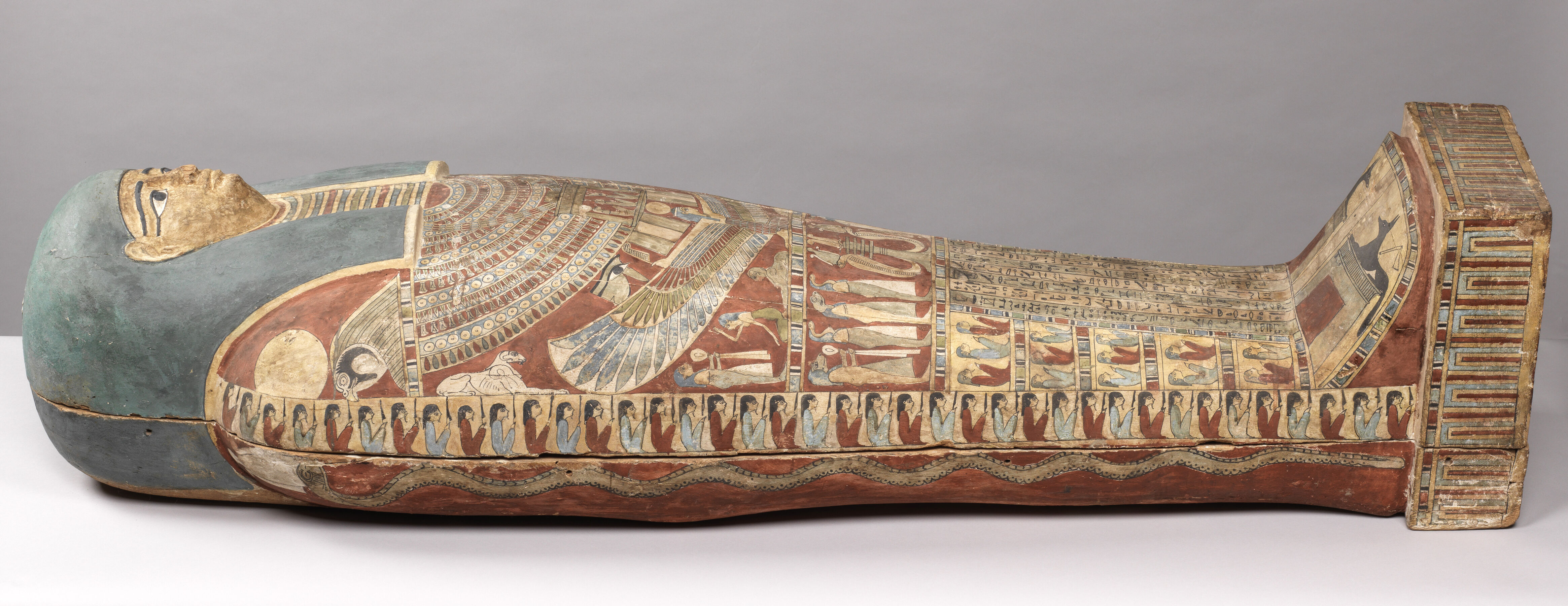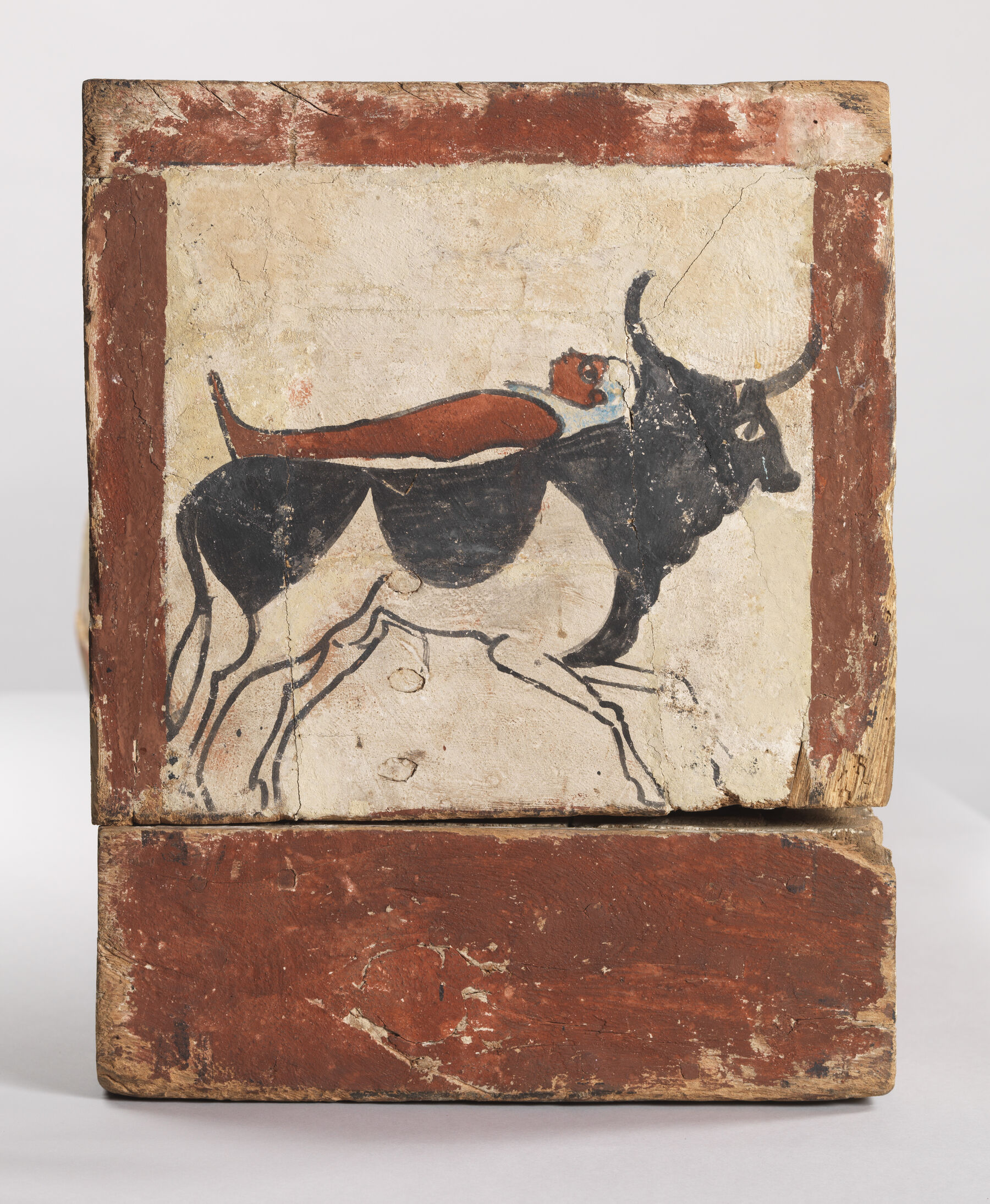Coffin Base and Lid Of Taosiris (Animation) by iuegypt on Sketchfab.
Taosiris’s coffin, like others manufactured during the first part of the reign of Ptolemy II (282–246 BCE), is brightly painted in a palette that, while predominantly red, still makes extensive use of yellow pigment as a background color, as well as light blue. The well-known Akhmimic coffin of Nes-Shou in Yverdon, Switzerland, belongs to the same period.1 The wig is done in light blue and surrounds a yellow face. The area between the wig lappets (neck zone) is painted with twelve U-shaped stripes or bands that alternate blue, light green, blue, and red, with beige and light-yellow ground color separations. In other analyses performed on Akhmimic coffins, this handling is one of the criteria for establishing early Ptolemaic styling, repeating three times on an off-white ground, forming a choker or upper collar distinct from the main collar design or falcon-headed broad collar (wesekhet-en-bik), covering the upper chest.2 The collar is decorated with three distinct floral motifs: (1) white rosettes schematized as circles on a blue ground; (2) a pattern termed “tied-and-folded leaf” on a divided ground red above blue; (3) and another pattern called “closed bud” on a red ground. These motifs are grouped as a unified trio, repeated four times. This repetition of floral motifs is common in Ptolemaic coffins produced at Akhmim. Tear-drop bangles form the lowest ring of the collar.
A large image of the sky goddess Nut fills the area directly below the collar. Her winged arms stretch across the width of the lid in a kind of protective embrace of the deceased. The goddess’s hands hold feathers symbolizing ma’at, the Egyptian concept of harmonious order.
The artist has filled the space below Nut’s wings with counterposed three-figure vignettes of a woman kneeling in an attitude of mourning in front of sphinxes. She renders homage to the sons of Horus named Imsety (human-headed, right) and Qebehsenuef (falcon-headed, left).
The register below these vignettes contains a central image of Osiris in the form of the Djed-pillar, the vertical vertebral column symbolizing duration and triumph over death. Cobra goddesses unfold protectively on each side of this important emblem. They face symmetrically arranged trios of mummiform deities. Each group is accompanied by a son of Horus, Hapi (baboon-headed, right), and Duamutef (jackal-headed, left). The heads of the trio members, long-necked serpents flanking a bulbous frog, identify them as primordial gods of fertility who established life at the world’s inception. Their presence next to the Djed-pillar indicates how death is followed by a return to the beginning of all things.
Inscriptions are lodged in seven columns alternating on blue and white grounds below the Djed-pillar. This textual “apron” is protected by five rows of gods. These profuse assemblies are a hallmark of Akhmimic coffin design in the Ptolemaic period. The inscriptions read from proper left to right:
-
Words spoken by Osiris, foremost of the west, great god, Lord of Abydos and Ptah-Sokar-Osiris [.…] great god [.…] in the midst of the shetayt-crypt
-
and Anubis, lord of the sacred land, and Anubis foremost of the god’s booth, and Isis the great, (divine mother); May they give
-
invocation-offerings of bread, beer, cattle, and fowl, wine, milk, incense, oil, alabaster and cloth, and everything good and pure (to) the ka-spirit of the Osiris
-
Taosiris, true-of-voice, daughter of Nesmin, true-of-voice, born of the mistress of the house Taamun, true-of-voice, [resume offering litany] (that) on which the god lives (it is) for me,
-
for the Hathor Taosiris, true-of-voice. An offering which the king gives (to) Osiris, foremost of the west, great god, lord of Abydos, and Sokar-Osiris,
-
who is in the midst of Ipw (Akhmim) and Aperet-iset of Ipw (Akhmim) and Anubis who-is-upon-(his)-hill, the one who is in the wt-fetish, lord of the sacred land, and Anubis, lord of Qerereti (the cavern of Asyut) and Anubis,
-
lord of the shrine-box; May he give a good burial upon the cutting? which is west of the wabet-sanctuary? (to) the Osiris Taosiris, true-of-voice, born of the house mistress.
Outline images of the goddess Nut with black details appear on the coffin lid and base interior surfaces. Her appearance assures the rebirth of the deceased like the self-generating sun.3 The jar-shaped emblem on the head of each image is a hieroglyph with the phonetic value “nu,” the main part of the name Nut. The tradition of showing Nut on the interior of coffins goes back centuries before the Ptolemaic period. Nut is herself identified with sarcophagi. The burial container is conceptually a womb for gestation and rebirth.
The edge of the lid is painted with detailed images of crouching gods and goddesses, their bodies alternating in light blue and red on yellow bands. Every figure is wide-eyed and holds a knife upon its knee. The inclusion of these large conclaves upon coffins recalls the Judgment of the Dead in the presence of Osiris formulated in Book of the Dead chapter 125. In it, forty-two assessors assist the god in determining the right of the deceased to enter the netherworld. The sides of Taosiris’s coffin aspire to create such assessor groups, but due to spatial limitations, it has only thirty-eight and forty deities on its sides (left and right, respectively).
The edges of the trough carry the images of a long cobra wearing an Atef-crown, an important part of the regalia of the god Osiris. Its placement opposite the groups of knife-wielding assessors indicates that the cobra is a kind of avatar of Osiris in his powerful judicial role. At the same time, the cobra and assessors are not a threat to the deceased. The coffin’s instep carries the motif of two recumbent jackals atop shrines. The jackal represents the god Anubis, who, as the “opener of the ways” (Wepwawet), guarantees the deceased freedom of movement within the netherworld realm.
The footboard of the coffin has a traditional image showing the Apis bull galloping with the mummy upon its back. The bull is a manifestation of Ptah, the creator god of ancient Memphis. The worship of Ptah was closely associated with rituals of Osirian rebirth. On Taosiris’s coffin, the mummy rests on the large figure of the bull, which has a white belly and saddle-shaped areas of black descending from its spine. The bull faces to the right, and other forms do not intrude on the scene. Similar handling of the Apis bull is found on the footboard of the Ptolemaic coffin of Mehytwesekhet in Wellington, New Zealand.4 Other coffins show the bull with a black underbelly and saddle-shaped zones of white falling from the back, running within a papyrus marsh.5 The coffin, cartonnage, and mummy of Taosiris were studied by an international group of experts who collaborate with the Akhmim Mummy Studies Consortium (see essay by Jonathan Elias in this volume).
JE
-
Küffer, Alexandra and Renate Siegmann, eds. 2007. Unter dem Schutz der Himmelsgöttin: Ägyptische Särge, Mumien, und Masken in der Schweiz. Zurich: Chronos.. ↩︎
-
Elias, Jonathan P. and Tamás Mekis. 2020. “Prophet-registrars at Akhmim.” MDAIK 76: 83–11.. ↩︎
-
Robins, Gay. 1997. The art of ancient Egypt. London: The British Museum Press.. ↩︎
-
Te Papa Tongawera FE 003200; https://collections.tepapa.govt.nz/object/149587. ↩︎
-
Kóthay, Katalin and Éva Liptay. 2010. Egyptian Artefacts in the Museum of Fine Arts, Budapest. Budapest: Museum of Fine Arts. (e.g., Budapest, Museum of Fine Arts 51.2097); Cockburn, Aidan, Robin A. Barraco, Theodore A. Reyman, and William H. Peck. 1975. “Autopsy of an Egyptian Mummy.” Science 187 (March): 1155–1160.. ↩︎
Bibliography
- Cockburn et al. 1975
- Cockburn, Aidan, Robin A. Barraco, Theodore A. Reyman, and William H. Peck. 1975. “Autopsy of an Egyptian Mummy.” Science 187 (March): 1155–1160.
- Elias & Mekis 2020
- Elias, Jonathan P. and Tamás Mekis. 2020. “Prophet-registrars at Akhmim.” MDAIK 76: 83–11.
- Kóthay and Liptay 2010
- Kóthay, Katalin and Éva Liptay. 2010. Egyptian Artefacts in the Museum of Fine Arts, Budapest. Budapest: Museum of Fine Arts.
- Küffer and Siegmann 2007
- Küffer, Alexandra and Renate Siegmann, eds. 2007. Unter dem Schutz der Himmelsgöttin: Ägyptische Särge, Mumien, und Masken in der Schweiz. Zurich: Chronos.
- Robins 1997
- Robins, Gay. 1997. The art of ancient Egypt. London: The British Museum Press.


